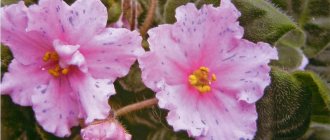Every Usambara violet is excellent. But it is rare to grow an even, symmetrical rosette and achieve the same lush flowering as professional violet growers.
What mistakes do lovers of indoor flowers make? How to grow the violet of your dreams Boo Men from the foreign breeder Sorano? Read the article about the dangers of improperly caring for Saintpaulia.
Botanical characteristics of Saintpaulia
The species that so many housewives now grow is called Uzambara violets. They were first discovered in eastern Africa at the end of the 19th century. The German soldier Walter Saint-Paul saw this plant taking root in moss on a stone.
He collected the seeds and sent them to Germany, where his scientific father grew the flower with the help of the director of the local botanical garden. Subsequently, the flower was named in honor of the discoverers - Saintpaulia.
The indoor violet belongs to the Gesnerieceae family. Most plants of this family are perennials, inhabitants of the neotropics region, which includes all of South America, Australia, India and some regions of Africa.
Under natural conditions, violets live near rivers and waterfalls, the splashes and moisture of which float in the air, providing the plant with water, because the violet can absorb it with its leaves and roots.
The ornamental plant tries to hide in the shade of tall trees so that the scorching rays of the tropical sun do not burn its delicate fluffy leaves with small hairs and flowers.
Such different violet flowers
Viola (garden violet) grows in open spaces, and Saintpaulia is only suitable for indoor growing, as it does not tolerate frost. The first genus belongs to the violet family, and the second to the Gesneraceae family.
Fragrant violet
An annual plant in which shoot budding occurs in the year preceding their growth. Once mature, the slender stems leave flower heads on the ground. Therefore, ripened seeds lie under the bush.
The peculiarity of this variety is that it overwinters with developed greenery. It tolerates cold well, but if the frost is too severe, it is better to cover it with spruce branches to prevent freezing. It loves moisture, but can rot as a result of prolonged stagnation of groundwater.
Violet graceful
Perennial with climbing stems. Inflorescences up to 4 cm, purple or yellowish. With the exception of the variety show Lord Nelson. This is a dark amethyst, almost black. Blooms from spring until frost.
Saintpaulia
This is a houseplant that is also called Usambara violet. It got its name from the area where it was found. Also because of the visual similarity to purple.
Varieties of violets for home cultivation
In the wild you can find about 20 species of Saintpaulia, differing in the shape and color of the leaves, the color of the peduncle and its shape. For home growing, you can choose any variety and even create multi-colored compositions from them, because caring for indoor violets at home in a pot is almost the same. If you learn to care for one species, you will have to do the same with others.
There are Saintpaulias:
- The size of the rosette is up to 8 cm, up to 15, up to 20 and standard 20 - 40 cm in diameter.
- According to flower size – small-, medium-, large-flowered and especially large.
- According to the shape of the flower structure - wasp, bell, pansy, classic violet and 2 star shapes - classic and round.
- According to the degree of “curly” peduncles: double, semi-double, simple, comb, clove.
Moreover, each subspecies can have several colors. There are two-color violets.
Genus Pansy
The flowers are double at the edges, most often arranged in two rows - small on top, larger on the bottom.
Variety Lions Pirates Treasure
The middle of the flower is bright pink. There is a purple border around the edge. A semi-double variety whose leaves also have a wavy texture at the edges.
Cinderella's Dream
The flowers are white, with a lilac edge, semi-double. The edges are jagged. The leaves are wavy.
Melody Kimi
The variety is deep blue in color with a light center.
Star
A variety of Pansies with petals of the same size, arranged in one row. The variety is classified as semi-double.
Caves Heavenly Star
Six-petalled, pink flower. The color resembles Lions Pirates Treasure, but the petals are arranged in one row.
Goddess of beauty
Belongs to terry varieties. It has a large rosette diameter and dark pink flowers, the petals of which are arranged in 3 rows above each other.
The magic of love
Purple terry Saintpaulias with white edging on the petals. The rosette is large and consists of dark green leaves.
Black Prince
The flowers of this double variety are brownish-burgundy in color. The yellow stamens in the center stand out brightly against the background of the languid color of the petals.
Rosemary
Terry tricolor: petals of lilac, pink and white.
Marshmallow
White-pink semi-double flowers with ruffled edges. The leaves are light green in color with elongated petioles. If the ambient temperature rises, the pink tint disappears from the color - the flowers turn white.
Austin smile
The rosette is compact, consisting of dark green pubescent leaves. The flowers are large, pale pink, the petals are arranged in one row. Along the edge there is a thin border of bright pink color.
Classification and popular varieties of indoor violets (Saintpaulia)
Saintpaulia is divided into:
- Collect those with large flowers. Almost all of them are terry, with folds. The blades and inflorescences come in different shades. Such Saintpaulias participate in exhibitions and are collected by collectors.
- Industrial, used for large-scale cultivation on special plantations. They are sold in large quantities to decorate holidays, offices, and administrative buildings. They do not require special care and bloom for a long time.
- They are full of brightly colored leaves of all shades and the presence of tassels. The first varieties had small flowers, later new hybrids with large inflorescences were bred.
Read more in the article Peaceful violet or Saintpaulia.
Depending on the type of leaves:
- girl - there is a light spot at the top at the base;
- spoon - with turned out edges.
- Spear - an elongated, pointed end;
- the boy is completely green;
Plates can also be:
- monochrome or variegated;
- heavily or sparsely covered, smooth.
- flat, with folds or depressions along the periphery;
Senopodia with inflorescences of different sizes in cm:
- semi-mini (up to 15);
- large (40-60).
- medium (20-40);
- mini (up to 6);
Classification by the number of additional petals:
- half flowers - 1-2 pieces in the center;
- Terry - there are many of them, they have different locations, they can be spherical or flat.
There is also a division according to the type of petals:
- Bell-shaped: connected at the base. Because of this feature, Saintpaulias cannot fully open the inflorescence.
- Wasp: Completely separated. Two are rolled into a tube, and three are elongated, hanging down.
- Star: equal length, spaced evenly from the center.
- Bowls: not broken, but the plant does not open them completely.
- Pansies: 2 in the top row, 3 in the bottom. And the top ones are smaller.
The size of the bush depends on the substrate: on nutritious soil mixture and low-growing Saintpaulias it grows to medium size.
There are also Saintpaulia chimeras with a clear line of contrasting color against the main background. Such varieties are in demand among collectors.
Lions Pirates Treasures
The buds are pink, framed with a strawberry tint. Covered with dirty lilac spots and dots. Blistered greens.
Melody Kimi
The leaves are embossed over the entire surface. Flowers are simple. The top two petals are blue, the rest are cut in the same shade.
Goddess of beauty
Emerald green forms a large, rooting bush. The inflorescences are bright, earthy, with an amethyst, mother-of-pearl hue.
Austin's smile
The blades form large rosettes. The flowers are star-shaped, solitary, purple-coral with a dark purple center and a crimson neckline.
EK-Admiral
The flowers are bell-shaped, cornflower blue, wavy. The leaves are cone-shaped, dark emerald. They have a creamy pink border around the circumference.
Robs Dandy Lyon
The inflorescences are large, bell-shaped. Colors in light green and beige tones. The foliage is dark malachite with bright white variegated leaves. Greenery forms rosettes.
Boo Man
Delicate bluish tint. The apical petals are pearlescent, sometimes greenish. Spoon-shaped plates, dark emerald color.
Ming Dynasty
The flowers are cup-shaped, heavily frilled, strawberry or lilac in color. The greenery is slightly variegated and wavy.
Luna Lily White
Leaves with a “quilted” texture, green in color, form a small basal bush. The inflorescences consist of semi-double panicle flowers.
Zemfira
The plates are colorful in the center. The petals are rolled into lilac tubes with frills.
Satellite
The inflorescences are amethyst-scarlet, reaching 15 cm. The greens are lettuce.
Blue Tail Fly
Blue variety. The lower petals are drooping, the upper ones are tubular. The foliage is tufted and forms clusters.
Gillian
Abundant, pearly flowers. Looks like a clove. Malachite leaves, rounded.
Robs Penny Ante
Snow-white, bell-shaped flowers. Dark azure eye in the center. The greens are slightly herbaceous.
Pink Sensation
Variegated variety with white-green leaves. The flowers are hemispherical, whitish, star-shaped. There are large, dull pink spots in the center of the flower.
Natalis Extravagant
The inflorescences are lacy, white-purple, with greenish, chocolate or pinkish edges. The leaves are malachite with lateral variegation.
Modern Talking
It belongs to the pansy. The flowers are frilly, hemispherical, white, with blue-purple-pink edges. The plates are flat, green.
Chain Reaction
The buds are large, slightly pudding-shaped, with a thin lilac line in the center. Sprinkled with specks of the same shade.
Queen Sabrina
Coral colored flowers. Each petal has thin amethyst stripes. The leaves are small, emerald green.
Music of the rain
The buds have a beige tint with a lilac border. Star-shaped, with a radius of 7 cm. The entire surface is covered with azure strokes and spots.
Chimpansy
The leaves are malachite-colored, with indentations. The flowers are a bright pudding color. There are wavy whitish lines running around the circumference. The surface is dotted with cornflower blue streaks and veins.
Currant dessert
Semicircular, lush, star-shaped flowers. They have a border of an unusual color, reminiscent of a shade of currant jam. Easy to grow.
Winter rose
The petals are blue-violet, with a barely noticeable whitish border around the perimeter. The mother bush conveys varietal characteristics well.
Baltika
Sea buckthorn with depressions, rich emerald color. The inflorescences are large, crescent-shaped, sky-purple, with a wide, fuzzy raceme of a whitish hue.
Alice Blizzard Baths
The flowers are small, pearly, with additional petals in the center. The blades are heart-shaped, light grassy in color.
Snow lace
Provides lush flowering. Fluffy, snow-white buds with a bluish spot in the center. Dull light green edging.
The bride's bouquet
The flowers are star-shaped, white, wavy at the edges. This Saintpaulia variety resembles a wedding bouquet. The petals are single-colored: there are no spots, streaks, or inclusions. Blooms profusely.
Georgia
The buds have raised folds, large, deep pink with lilac dots. There is a delicate light green border. With proper care it blooms profusely.
Marquise
Large, swollen flowers with a strawberry hue. The perianth has a lilac fringe with a thin pearlescent line. Emerald green.
Magdalene
Ball-shaped, fluffy flowers grow from lettuce rosettes. They are wavy around the perimeter. Growing close to each other, they create the impression of a huge bouquet. This variety was presented at flower exhibitions.
Lilac beauty
Rounded leaves form into a rosette. The flowers are amethyst with a lilac center and a dark border. Grows on thick stems. This variety is very easy to care for. He can also be raised by children.
Favorite daughter
The serrated blades are rounded, dark emerald on the outside and crimson on the inside. The plant lifts them up, closer to the sun. At the beginning of formation, the flowers are dark and small. Then they lighten, acquiring a lilac color with a mother-of-pearl border. Flowering is colorful and observed within 2-3 weeks.
Blue Dragon
The buds are large, azure in color. Framed by a greenish-white line. The variety is capricious; with the slightest lack of care, it can get sick and wither.
Blue Danube
Grown in Russia. Produces large, sky-colored flowers. The leaves are matte, embossed, with pointed tips. Grows quickly with intense light and regular watering.
Blue Lagoon
Large, star-shaped flowers. Azure, with a cornflower blue spot in the center and a purple border. Blooms for about 2 months. It does not require special care and can be grown even by a beginner.
lemon snow
The petals are pearlescent, with yellowish veins. The center and edges are painted in lapis lazuli color. Variegated variety: malachite plates with a snowy outline.
Villodene
The foliage is variegated: emerald with strawberry or white spots. The plates are curved along the entire perimeter. Apricot-colored flowers with a light green border.
Gift for a loved one
Decorative - green: rich herbaceous color with a whitish earthy border. The buds are blue with a purple base. Participates in flower exhibitions. However, it is quite easy to care for.
Velvet
The leaves are malachite on the outside and reddish on the inside. The petals are amethyst with a darker line in the middle.
Violetflower
The shoots are poorly developed. The leaves are heart-shaped, green, in the shade. The inflorescences are bluish-lilac.
Rosemary
With emerald jagged plates. Star shaped flowers with frills, blue flecks and strawberry accents on a white background.
Caprice
The greenery is variegated and wavy. The inflorescences are lush and white. The corolla is decorated with light green tassels.
Fire Moths
The leaves are oval, green. The corolla is fiery red or burgundy. The border is wide, pink or snow-white. The border changes shade throughout the growing season.
The magic of love
The flowers are lush, densely branched, resembling pompoms. The petals are arranged in the shape of a star. Color: beetroot. There is a neat pearlescent line along the edges.
Rose of Wind
The flowers are light purple with a strawberry pattern, which in places takes on a greenish tint.
Macho
A variety with large flowers. The petals are star-shaped, burgundy, amethyst with a whitish curved line along the periphery. The leaves are simple, ovate.
Flower shape - bell
Violets, whose flowers resemble bells in shape, are not able to fully open due to the structural features of the peduncle: the fused bases of the petals. There are several specimens of this species worthy of home breeding.
Admiral
Flowers are cornflower blue with wavy edges. The variety is classified as semi-double. The leaves have decorative value: they have a white edge on a dark green background.
Sea wolf
Why they gave such a name to soft lilac terry violets is not clear. The variety has a large dark green bunch of leaves in a rosette. Blooms luxuriantly. The petals are wavy, arranged in 2 rows. With proper care they grow up to 8 cm in diameter.
Chanson
One of the easiest types of violets to care for. It blooms magnificently, producing several buds at once. The color is blue with pink spots. It is impossible to find two completely identical flowers.
Miniature violets Boo Man, Mac's Callow Carillion, Alan's White Feather and others.
Despite all the reforms and vicissitudes on the site, our favorite violets continue to bloom and delight us with their flowering. I will be pleased if, while viewing several new varieties, and for some already familiar ones, you get a little pleasure.
Boo Man - Sorano - semi-mini.
All lovers of miniature violets probably have this variety. He is very popular and there is a lot to love about him.
Semi-double and double pale blue flowers with a beautiful, delicate frill along the edge of the petals. The buds and newly opened flowers have green splashes that disappear as they grow. True blue color fades into white.
The flowers are quite large for a miniature, light and airy.
A bouquet of soft blue flowers does not lose its attractiveness for a very long time. This rosette bloomed for about 2 months. The rosette is also very beautiful. The leaves are slightly elongated, black-green in color with a burgundy underside, and shiny. Against the background of almost black foliage, sky-blue, airy flowers look great! This rosette is blooming for the first time; there are only 3 peduncles, each with at least 5 flowers.
Mac's Callow Carillion - McDonald - Half Mini.
These snow-white, bell-shaped flowers have a wide green stripe along the edge of the petals. The flowers are very delicate and touching. Looking at them, you involuntarily think about spring, although it is only deep autumn now, but you can dream a little...
The rosette of this variety has light green oval foliage, slightly quilted. Very delicate and beautiful variety! It blooms often and always in a bouquet; If you don’t help the peduncles get out from under the leaves and take a vertical position, then the peduncles fall on the rosette, but it also turns out beautifully.
Alan's White Feather - Murphy - semi-mini.
On a medium-sized rosette, just over 10 cm, large white bells with a beautiful wavy edge bloom (in this photo the pink color came from somewhere, please excuse the quality of the photo). Flowers can be simple or semi-double. The sparkling petals are amazingly beautiful!
There is no need to expect the rosette to bloom quickly. For me, the rosette did not bloom until it had 4 full rows of leaves. Light green, pointed leaves form a rosette with even, dense rows. This is the first flowering.
Rob's Penny Ante - Robinson - miniature.
This variety has flowers that are semi-double and white, half bell-shaped. The purple-blue center of the flower gradually melts away. Along the edges of the petals there is also a thin purple-blue border.
This variety is not demanding on living conditions; grows quickly, blooms early. The rosette is a little loose due to the fact that the stem lengthens quite quickly, but the rows are even, and when the flowers bloom, it’s simply lovely!
Orchard's Wonder Twin - Wilson - mini.
A large number of double white flowers with soft pink shades flaunt above the rosette. Basically, pink spots are located in the center of the flower.
At the beginning of the blossoming of flowers, the lower petals are slightly greenish and all the flowers seem to be covered with mother-of-pearl, glitter and sparkle.
A very neat, even rosette with light green pointed leaves. The size of the socket can be judged from this photo
And now I’ll show you a few more photos of rosettes of the varieties I’ve already talked about.
Sassy Sister.
I really like this variety and therefore, when it bloomed again, and it blooms often, I decided to share this beauty with you. When I showed it for the first time, the rosette was very young and there was no such splendor.
Rob's Doohickey.
I already talked about this variety, but recently it bloomed again with even larger flowers and a large, beautiful “cap”. And if you look at the rosette from the top, the leaves are practically invisible.
Irish Flirt:
This beauty also blooms quite often. I can’t calmly look at this white and green miracle!
That's all. The show and tell of my babies is over. I will be glad if you liked them.
Variety of violets "Chalice"
These are some of the most beautiful varieties with different colors and peduncle shapes. The bases of the petals are less fused than those of bells, but the flowers do not fully open, maintaining the shape of a wide bowl.
Ming Dynasty
The most beautiful variety of this type of violet: white peduncles with a pink tint along the edge of heavily corrugated large leaves.
Bu Meng
Varieties of violets are double and semi-double. The flowers are light blue. The petals are arranged in several rows, have a round shape, not corrugated.
Varieties of violets "Osa"
The peduncles are distinguished by an unusual structure: the two upper shortened petals have the shape of a tube. The other three elongated ones hang down.
Lily White
The flowers are completely white, the petals are separated. They are narrower than other varieties. The rosette is small, but the peduncles are large - up to 4 cm.
Satellite
Purple flower stalks with an unusual shape: a tube and two ordinary petals. The leaves are dark green, vesicular in structure.
Zemfira
Saintpaulias are a deep purple hue, very wavy at the edges. The lower part of the peduncle is pink.
Spring care
Caring for violets in a pot at home is to ensure that they bloom. If the plant produces buds, it means it is healthy and has strong immunity. This is influenced by several factors:
- Proper watering. Violets should not be watered from above so that water gets into the internodes, leaves, and buds. This causes tissue rotting due to fungal infection.
- Lighting. Direct sunlight in summer is especially dangerous for violets. They cause leaf burns. A damaged plant will not bloom.
- Feeding. To grow buds, Saintpaulias consume a lot of nutrients, especially potassium and phosphorus, but ordinary fertilizers are not suitable for them - you need to buy a mixture for violets. In addition, it is necessary to maintain an acidic soil environment, since excess carbonates leads to withering of plants.
- Proper planting in a pot. You cannot replant violets into large pots, because they spend all their energy on growing the root system, so they forget to bloom at the right time.
Video: Violets for beginners
In the spring, when the plant wakes up, all the main activities are carried out with it. How to care for violets at home so that they bloom all summer long:
- At the beginning of March, it is necessary to feed those plants that are not planned to be replanted with a mixture for violets. It is carried out by watering at the root. Before fertilizing, moisten the soil, then drain the remaining liquid from the pan. The soil should be constantly moist, but without stagnant water.
- In the spring, the rosettes are thinned out - the lower leaves that formed first are removed. They won't grow anymore, so there's no point in wasting nutrients on them.
- In the spring, those violets that have grown since last year are replanted.
If plants are transplanted into new soil, fertilizing is not carried out.
Reproduction
Caring for and propagating miniature violets requires a more attentive attitude and is slightly different from standard varieties.
If a person decides to grow a violet from a leaf, it is necessary to keep in mind that it is better not to root it in water, since due to its miniature size it can quickly rot. You can place a leaf in the liquid to restore moisture if it has wilted a little after transportation.
After the leaf has restored the loss of moisture, it is necessary to trim it from the bottom by 1 cm. Sprinkle the cut itself with coal and plant it in light, moist soil. In this case, it is necessary to deepen it in the ground by half the plate.
For faster rooting, the planted leaf should be placed in a greenhouse or covered with polyethylene. Watering should be done as the soil dries out.
Over the course of a week, the polyethylene is opened for a while, increasing the duration every day, and then it can be removed completely. For the development and growth of the emerging rosette, it is necessary to maintain the air temperature within 22-24 degrees, create diffuse lighting lasting from 12 to 14 hours a day.
As they grow, young rosettes of violets are transplanted into separate pots. Rooted plants bloom within 5-7 months.
Summer events
How to care for violets in summer at home:
- Periodic bathing to remove dust from fuzzy leaves. It is carried out in hot weather to dry faster. Flowers cannot be washed - only leaves. The soil is covered with film. 2 baths per month are enough
- In summer, fertilizing is carried out once a month with a complex mixture with a low amount of nitrogen.
In summer, Saintpaulias are shaded from direct sunlight on the windowsill.
Features of flowering, growth and reproduction
Boo Man (Sorano) is a violet with powerful and thick leaf cuttings; dense and succulent foliage makes the rosette visually large.
Requires a lot of water when watering and regular fertilizing during bud formation and flowering.
Development at home
This variety of Uzambara violet is surprisingly unpretentious and very easy to care for. It is resistant to adverse factors and is well suited for beginning gardeners.
Important! When growing on a wick, it is better to choose a tight pot, preferably a size five. Otherwise, instead of a miniature violet, a standard one will grow.
With good care, a young plant quickly increases its leaf mass. From the moment the cutting is planted until the adult rosette is ready for lush flowering, it takes about 10 months.
Adult violet Boo Men.
Methods and features of variety propagation
Varietal violet Boo Man (Sorano) perfectly conveys varietal characteristics when propagated by leaf cuttings.
This variety can also be propagated:
- stepchildren;
- rooting of flower stalks
The best time for propagation by leaf cuttings is spring. Leaf cuttings planted in the ground quickly produce strong offspring, and after 6 months you will get a strong starter.
Features of flowering varieties in hot and cool conditions
The variety has proven itself best when flowering in cool conditions. At a temperature not exceeding 18-20 degrees.
The peduncles are strong, stand well and easily support a dense head of flowers.
The variety has very good potential; with proper care, even a novice gardener can achieve cap flowering.
Flowers reach their full bloom potential the first time . The buds open together and delight with long-lasting flowering.
Propagation of Saintpaulia
Propagation of violets by leaves at home is carried out in cases where it is necessary to save the plant after improper care. If the cuttings begin to rot and no stepson have grown, there is only one way left - leaf.
To do this, take a sheet, cut off all the rotten parts and lay it on the ground. Place a glass of soil under a plastic bag and wait for roots to form (for this, the leaf must have veins from which they grow).
Cuttings are a propagation method in which the entire leaf with stem is used. How to propagate violets, step-by-step process:
- A leaf with a stem breaks off from a violet.
- Placed in water to grow roots. Can be stimulated by root, epin. An activated carbon tablet is placed in the water to prevent the cuttings from rotting.
- Transplanted into the ground.
Stepchildren grow from strong, healthy violets. They are cut and placed in water to grow roots, then planted in pots.
Chimera violets, which have stripes of a different color on the main petal color, can only be propagated by peduncles. These are rare varieties that do not retain their maternal characteristics when propagated by cuttings and leaves. You need to choose a flower that is in bloom or one that is already fading. It is cut off and wrapped in damp sphagnum moss.
It is advisable to place it under a bag, setting up a greenhouse. You can replant when several leaves form nearby.
Choosing a pot
Violets do not like large containers for replanting, so you need to choose a pot 1 - 2 cm larger than the previous one, so that the roots grow a little, the rest of the energy will be spent on flowering. An adult plant needs a container 13 cm in diameter.
Caring for a plant at home
An ideally shaped rosette grows with good care. Often an adult rosette slightly bends the foliage down, as if hugging the pot a little.
Conditions of detention
The Boo Man (Sorano) variety can be grown on an eastern, northeastern or western windowsill , where the flower will have enough light. The variety has also proven itself well when grown on a rack with equipped lighting.
Proper watering and fertilizing
You can water the Boo Man (Sorano) variety using wick watering or pour water into a tray , or slowly pour it into the pot from above .
Important! When using wick irrigation, only soilless mixture should be used. Watering through a wick is a delicate matter that requires attention and accuracy, otherwise the death of the violet cannot be avoided.
Lighting and temperature
To grow Saintpaulia and obtain lush flowering, you need to maintain the room temperature between 18 and 23 degrees.
Optimal temperature for violets.
And make sure there is sufficient lighting. Daylight hours should be at least 10 hours.
Air humidity
Indoor humidity is one of the important factors when growing violets. The plant especially suffers in winter, when indoor heating devices dry out the air.
Therefore, in winter you should additionally humidify the air and try to constantly maintain humidity within 50-60%.
Priming
Each gardener selects the ideal soil composition to suit his or her own conditions. The main components of soil for Saintpaulias:
- high peat;
- vermiculite;
- perlite;
- foam balls;
- sphagnum moss.
This is interesting! It turns out that to prevent mold from forming on the surface and salts deposited on top of the ground from spoiling the appearance, Americans regularly clean off and replace the top two centimeters of soil. That's the whole secret of the perfection of American technology.
Pruning and hygiene
It is necessary to form a rosette from the moment the baby grows. Timely removal of juvenile young leaves, as well as pruning of dried or deformed leaves.
Once a month, it is necessary to carry out bathing procedures and carefully wash off the collected dust from the violet leaves under running water.
Shower for violet.
Reproduction methods
The variety reproduces:
- leaf cuttings;
- rooting of flower stalks;
- separated from the mother's outlet by stepsons.
The variety does not propagate by seeds.
Rules for transplantation, plant rejuvenation
Grown-up children and starter plants are replanted as the root mass grows . At the same time, they try to preserve the earthen lump as much as possible.
to rejuvenate an old violet :
- A small bare stem is deepened into the substrate to the lower leaves, and part of the roots are removed;
- If the violet trunk is more than 2 cm, it is cut off, leaving a small stump, and the edge of the trunk is cleaned like a carrot. Then they put it in water for rooting or immediately plant it in a new prepared substrate and be sure to place it in a greenhouse until new roots appear.
Feeding
In addition to the main nutrients, the fertilizer for Saintpaulia includes microelements. They are needed to stimulate metabolism and absorb macroelements. After transplantation, adult plants are not fertilized for 8 weeks. If the specimen becomes ill, it is necessary to wait until vital activity is restored. During this period, nutrient mixtures are not added to the soil.
The basic rule for fertilizing is to first moisten the soil, wait 2–3 days, then add the nutrient mixture. This approach will not harm the plant. In the spring, mixtures with a high nitrogen content are used to help the violet grow a lush rosette of leaves, then potassium-phosphorus fertilizers are added with the addition of boron, which stimulates metabolism and flowering.
Important! To prevent salts from accumulating in the soil, the soil is shed with a solution of potassium permanganate once a month during the growing season. After this, drain the liquid from the pan











